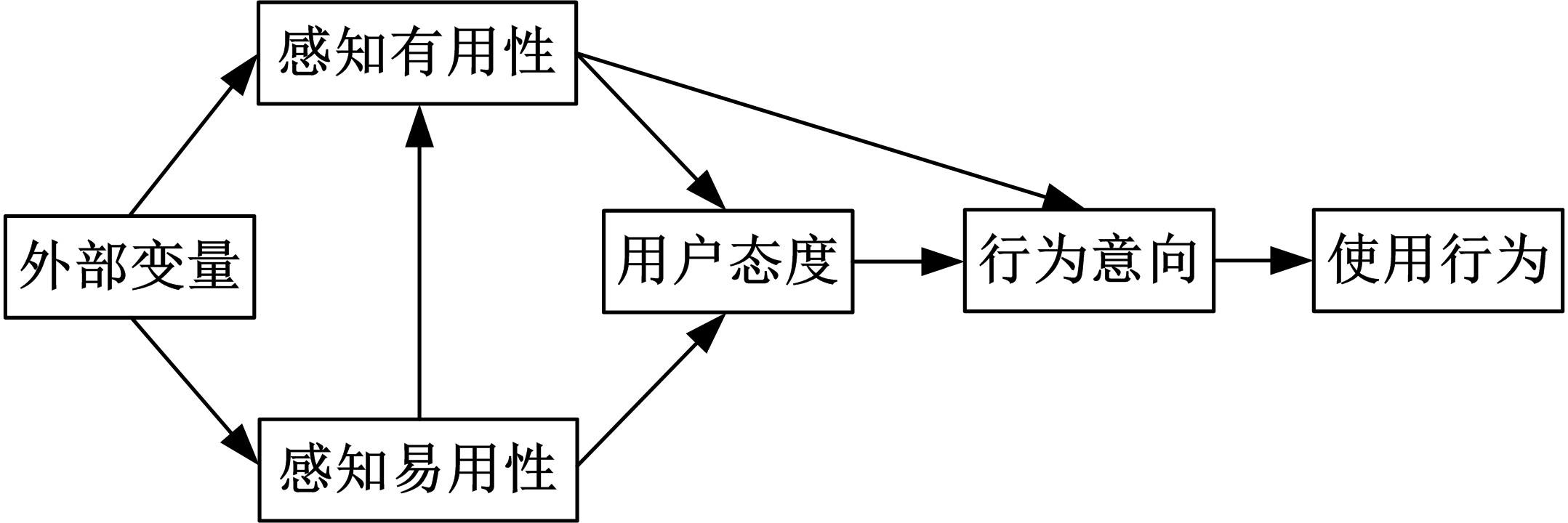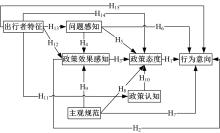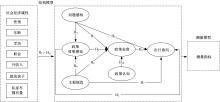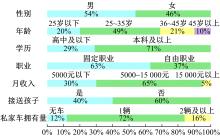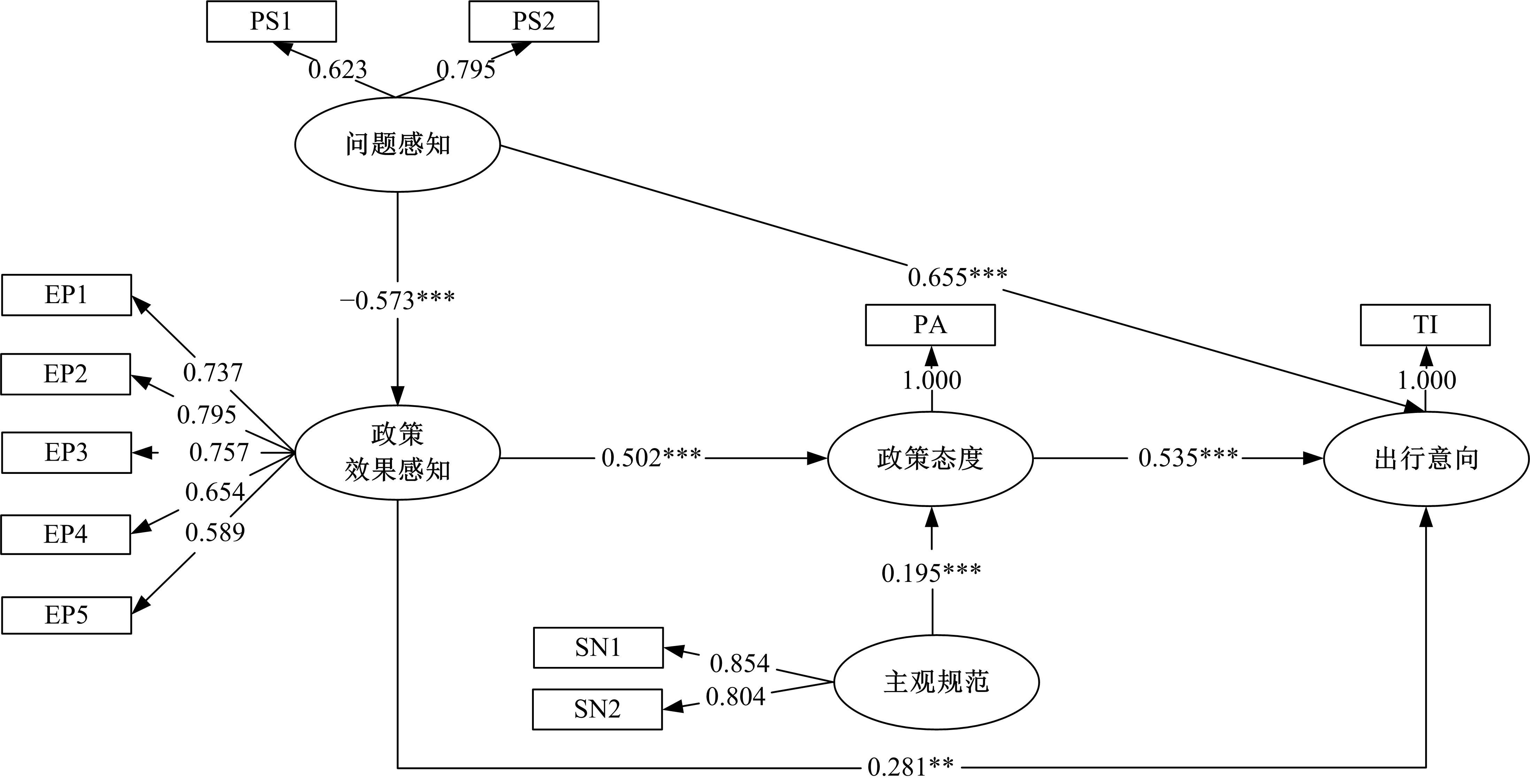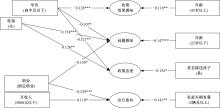Journal of Jilin University(Engineering and Technology Edition) ›› 2022, Vol. 52 ›› Issue (11): 2607-2617.doi: 10.13229/j.cnki.jdxbgxb20210388
Urban residents' low⁃carbon travel intention after implementation of driving restriction policy
Zhuang-lin MA1( ),Shan-shan CUI2,Da-wei HU1
),Shan-shan CUI2,Da-wei HU1
- 1.College of Transportation Engineering,Chang'an University,Xi'an 710064,China
2.Shandong Provincial Communications Planning and Design Institute Group Co. ,Ltd. ,Jinan 250031,China
CLC Number:
- U491
| 1 | Grange L D, Troncoso R. Impacts of vehicle restrictions on urban transport flows: the case of Santiago, Chile[J]. Transport Policy, 2011, 18(6): 862-869. |
| 2 | Yang Y L, Guo Y Y, Luo S Q. Consumers' intention and cognition for low-carbon behavior: a case study of Hangzhou in China[J]. Energies, 2020, 13(21): 1-19. |
| 3 | Fishbein M, Belief Ajzen I., Attitude, Intention and Behavior : an Introduction to Theory and Research[M]. Massachusetts: Addison-Wesley Publishing Company, 1975. |
| 4 | Hu X J, Wu N, Chen N. Young people's behavioral intentions towards low-carbon travel: extending the theory of planned behavior[J]. International Journal of Environmental Research and Public Health, 2021, 18(5): 18052327. |
| 5 | Schuitema G, Steg L, Forward S. Explaining differences in acceptability before and acceptance after the implementation of a congestion charge in Stockholm[J]. Transportation Research Part A: Policy and Practice, 2010, 44(2): 99-109. |
| 6 | Gu Z, Liu Z, Cheng Q, et al. Congestion pricing practices and public acceptance: a review of evidence[J]. Case Studies on Transport Policy, 2018, 6(1): 94-101. |
| 7 | Schade J, Schlag B. Acceptability of urban transport pricing strategies[J]. Transportation Research Part F: Traffic Psychology and Behavior, 2003, 6(1): 45-61. |
| 8 | Geng J C, Long R Y, Chen H, et al. Exploring the motivation-behavior gap in urban residents' green travel behavior: a theoretical and empirical study[J]. Resources Conservation & Recycling, 2017, 125: 282-292. |
| 9 | Vos J D, Witlox F. Travel satisfaction revisited, on the pivotal role of travel satisfaction in conceptualising a travel behaviour process[J]. Transportation Research Part A: Policy and Practice, 2017, 106: 364-373. |
| 10 | Gaunt M, Rye T, Allen S. Public acceptability of road user charging: the case of edinburgh and the 2005 referendum[J]. Transport Reviews, 2007, 27(1): 85-102. |
| 11 | Eriksson L, Garvill J, Nordlund A M. Acceptability of travel demand management measures: the importance of problem awareness, personal norm, freedom, and fairness[J]. Journal of Environmental Psychology, 2006, 26(1): 15-26. |
| 12 | Khademi E, Timmermans H. The long-term effectiveness of a reward scheme in changing daily travel choices[J]. Procedia Social & Behavioral Sciences, 2014, 111: 380-389. |
| 13 | Gärling T, Schuitema G. Travel demand management targeting reduced private car use: effectiveness, public acceptability and political feasibility[J]. Journal of Social Issues, 2010, 63(1): 139-153. |
| 14 | Jia N, Zhang Y D, He Z B, et al. Commuters' acceptance of and behavior reactions to license plate restriction policy: a case study of Tianjin, China[J]. Transportation Research Part D: Transport and Environment, 2016, 52: 428-440. |
| 15 | 温旭丽, 杨悦, 叶欣. 大城市居民出行轨道交通选择意向研究[J]. 公路交通科技: 应用技术版, 2012(8): 356-359. |
| Wen Xu-li, Yang Yue, Ye Xin. Study on urban residents' choice of rail transit in big cities[J]. Journal of Highway and Transportation Search and Development(Application Technology Edition), 2012(8): 356-359. | |
| 16 | 颜冉, 储金龙, 杨新刚. 城市居民使用共享单车意向研究——以合肥为例[J]. 交通信息与安全, 2017, 35(6): 101-107, 114. |
| Yan Ran, Chu Jin-long, Yang Xin-gang. Intention of urban residents to use public bike sharing system: a case study in hefei[J]. Journal of Transport Information and Safety, 2017, 35(6): 101-107, 114. | |
| 17 | Liu Y X, Hong Z S, Liu Y. Do driving restriction policies effectively motivate commuters to use public transportation?[J]. Energy Policy, 2016, 90: 253-261. |
| 18 | 侯现耀,陈学武.基于态度的公交出行信息使用市场细分[J].吉林大学学报:工学版,2018,48(1): 98-104. |
| Hou Xian-yao, Chen Xue-wu. Use of public transit information market segmentation based on attitudinal factors[J]. Journal of Jilin University(Engineering and Technology Edition), 2018, 48(1): 98-104. | |
| 19 | 刘宇峰, 钱一之, 胡大伟, 等. 基于结构方程模型的不同规模城市居民出行方式选择影响因素的关联性分析[J]. 长安大学学报: 自然科学版, 2018, 38(5): 93-101. |
| Liu Yu-feng, Qian Yi-zhi, Hu Da-wei, et al. Correlation analysis of travel mode choice for urban residents in different urban size based on structural equation model[J]. Journal of Chang'an University(Natural Science Edition), 2018, 38(5): 93-101. | |
| 20 | Bollen A. Structural Equations with Latent Variables[M]. New York: John Wiley & Sons Inc., 1989. |
| 21 | Allen J, Bellizzi M G, Eboli L, et al. Service quality in a mid-sized air terminal: a SEM-MIMIC ordinal probit accounting for travel, sociodemographic, and user-type heterogeneity[J]. Journal of Air Transport Management, 2020, 84: 101780. |
| 22 | Ingvardson J B, Nielsen O A. The relationship between norms, satisfaction and public transport use: a comparison across six european cities using structural equation modelling[J]. Transportation Research Part A: Policy and Practice, 2019, 126: 37-57. |
| 23 | 舒诗楠, 边扬, 荣建, 等. 短距离下小汽车出行向自行车出行转移意向MIMIC模型[J]. 北京工业大学学报, 2019, 45(10): 998-1008. |
| Shu Shi-nan, Bian Yang, Rong Jian, et al. Transition from driving to bicycling in short-distance travel based on MIMIC model[J]. Journal of Beijing University of Technology, 2019, 45(10): 998-1008. | |
| 24 | Zailani S, Iranmanesh M, Masron T A, et al. Is the intention to use public transport for different travel purposes determined by different factors?[J]. Transportation Research Part D: Transport and Environment, 2016, 49: 18-24. |
| 25 | 胡松, 翁剑成, 周伟, 等. 基于扩展计划行为理论的公共交通出行依赖性影响[J]. 吉林大学学报: 工学版, 2022, 52(5): 1037-1044. |
| Hu Song, Weng Jian-cheng, Zhou Wei, et al. Influence of travelers' dependence on public transportation based on extended theory of planning behavior[J]. Journal of Jilin University(Engineering and Technology Edition), 2022, 52(5): 1037-1044. | |
| 26 | Chen S Y. Green helpfulness or fun?Influences of green perceived value on the green loyalty of users and non-users of public bikes[J]. Transport Policy, 2016, 47: 149-159. |
| 27 | 齐航, 夏嘉祺, 王光超, 等.考虑出行者习惯与利他性偏好的自动驾驶网约车使用意向模型[J]. 交通运输工程与信息学报, 2021, 19(2): 1-10. |
| Qi Hang, Xia Jia-qi, Wang Guang-chao, et al. A behavioral intention to use model of autonomous vehicle ride-hailing incorporating traveler habit and altruistic preference[J]. Journal of Transportation Engineering and Information, 2021, 19(2): 1-10. | |
| 28 | 王月辉,梁江伟,范实,等.基于技术接受模型(TAM)的网约车出行意向影响因素研究[C]∥第十九届中国管理科学学术年会, 南京,中国, 2017: 694-700. |
| 29 | Chen C F, Chao W H. Habitual or reasoned?using the theory of planned behavior, technology acceptance model, and habit to examine switching intentions toward public transit[J]. Transportation Research Part F: Traffic Psychology and Behavior, 2011, 14(2): 128-137. |
| 30 | Chen S Y. Using the sustainable modified TAM and TPB to analyze the effects of perceived green value on loyalty to a public bike system[J]. Transportation Research Part A: Policy and Practice, 2016, 88: 58-72. |
| 31 | Ajzen I. The theory of planned behavior[J]. Organizational Behavior and Human Decision Processes, 1991, 50(2): 179-211. |
| 32 | Davis F D, Bagozzi P R, Warshaw P. User acceptance of computer technology: a comparison of two theoretical models[J]. Management Science, 1989, 35(8): 982-1003. |
| 33 | Schlag B, Teubel U. Public acceptability of transport pricing[J]. IATSS Research, 1997, 21(2): 134-142. |
| 34 | 罗艳菊, 黄宇, 毕华, 等. 基于环境态度的城市居民环境友好行为意向及认知差异——以海口市为例[J]. 人文地理, 2012, 27(5): 75-81. |
| Luo Yan-ju, Huang Yu, Bi Hua, et al. Difference in urban residents' pro-environmental behavior intention and understanding based on their environmental attitude a case study of haikou[J]. Human Geography, 2012, 27(5): 75-81. | |
| 35 | Nico D, Yue B, Meng X, et al. Acceptability of a tradable driving credit scheme in the Netherlands and Beijing[J]. Case Studies on Transport Policy, 2018, 6(4): 499-509. |
| 36 | Rentziou A, Milioti C, Gkritza K, et al. Urban road pricing: modeling public acceptance[J]. Journal of Urban Planning & Development, 2011, 137(1): 56-64. |
| 37 | 和占琼, 姜玉婷, 何明卫. 城市通勤者低碳出行选择研究——基于TPB与VBN整合模型[J]. 干旱区资源与环境, 2019, 33(4): 89-95. |
| He Zhan-qiong, Jiang Yu-ting, He Ming-wei. Study on urban low carbon travel choice based on TPB and VBN integration model[J]. Journal of Arid Land Resources and Environment, 2019, 33(4): 89-95. | |
| 38 | 吴文静, 景鹏, 贾洪飞, 等. 基于K均值聚类与随机森林算法的居民低碳出行意向数据挖掘[J]. 华南理工大学学报: 自然科学版, 2019, 47(7): 105-111. |
| Wu Wen-jing, Jing Peng, Jia Hong-fei, et al. Low carbon travel intention data mining for residents based on K-means clustering and random forest algorithm[J]. Journal of South China University of Technology (Natural Science Edition), 2019, 47(7): 105-111. |
| [1] | Song FANG,Jian-xiao MA,Gen LI,Ling-hong SHEN,Chu-bo XU. Traffic risk analysis of moving work zone on right lane of city expressway [J]. Journal of Jilin University(Engineering and Technology Edition), 2022, 52(8): 1786-1791. |
| [2] | Song-xue GAI,Xiao-qing ZENG,Xiao-yuan YUE,Zi-hao YUAN. Parking guidance model based on user and system bi⁃level optimization algorithm [J]. Journal of Jilin University(Engineering and Technology Edition), 2022, 52(6): 1344-1352. |
| [3] | Hong-feng XU,Hong-jin CHEN,Dong ZHANG,Qian-hui LU,Na AN,Xian-cai Geng. Fully⁃actuated signal timing technique for isolated signalized intersections in connected vehicle environment [J]. Journal of Jilin University(Engineering and Technology Edition), 2022, 52(6): 1324-1336. |
| [4] | Jie MA,Jia-jun HUANG,Jun TIAN,Yang-hui DONG. Simulation modeling of pedestrian target decision⁃making in evacuation process in transfer corridors of subway stations [J]. Journal of Jilin University(Engineering and Technology Edition), 2022, 52(11): 2600-2606. |
| [5] | Heng-yan PAN,Wen-hui ZHANG,Bao-yu HU,Zun-yan LIU,Yong-gang WANG,Xiao ZHANG. Construction and robustness analysis of urban weighted subway⁃bus composite network [J]. Journal of Jilin University(Engineering and Technology Edition), 2022, 52(11): 2582-2591. |
| [6] | Jing-xian WU,Hua-peng SHEN,Yin HAN,Min YANG. Residents' commuting time model under the nonlinear impact of urban built environment [J]. Journal of Jilin University(Engineering and Technology Edition), 2022, 52(11): 2568-2573. |
| [7] | Feng XUE,Chuan-lei HE,Qian HUANG,Jian LUO. Coordination degree of multimodal rail transit network [J]. Journal of Jilin University(Engineering and Technology Edition), 2021, 51(6): 2040-2050. |
| [8] | Bo PENG,Yuan-yuan ZHANG,Yu-ting WANG,Ju TANG,Ji-ming XIE. Automatic traffic state recognition from videos based on auto⁃encoder and classifiers [J]. Journal of Jilin University(Engineering and Technology Edition), 2021, 51(3): 886-892. |
| [9] | Dian-hai WANG,Xin-yi SHEN,Xiao-qin LUO,Sheng JIN. Offset optimization with minimum average vehicle delay [J]. Journal of Jilin University(Engineering and Technology Edition), 2021, 51(2): 511-523. |
| [10] | Xian-min SONG,Ming-ye ZHANG,Zhen-jian LI,Xin WANG,Ya-nan ZHANG. Setting of dynamic bus lane and its simulation analysis and evaluation [J]. Journal of Jilin University(Engineering and Technology Edition), 2020, 50(5): 1677-1686. |
| [11] | Hong-fei JIA,Xin-ru DING,Li-li YANG. Bi-level programming model for optimization design of tidal lane [J]. Journal of Jilin University(Engineering and Technology Edition), 2020, 50(2): 535-542. |
| [12] | Chao-ying YIN,Chun-fu SHAO,Xiao-quan WANG,Zhi-hua XIONG. Influence of built environment on commuting mode choice considering spatial heterogeneity [J]. Journal of Jilin University(Engineering and Technology Edition), 2020, 50(2): 543-548. |
| [13] | Da-wei ZHANG,Hai-tao ZHU. An optimization⁃based evacuation model considering pedestrian heterogeneity [J]. Journal of Jilin University(Engineering and Technology Edition), 2020, 50(2): 549-556. |
| [14] | Yuan-li GU, Yuan ZHANG, Xiao-ping RUI, Wen-qi LU, Meng LI, Shuo WANG. Short⁃term traffic flow prediction based on LSSVMoptimized by immune algorithm [J]. Journal of Jilin University(Engineering and Technology Edition), 2019, 49(6): 1852-1857. |
| [15] | Yi-ming BIE,Kai JIANG,Ru-ru TANG,Lin-hong WANG,Xin-yu XIONG. Time of interval partition for traffic control at isolated intersection considering impacts of plan transition [J]. Journal of Jilin University(Engineering and Technology Edition), 2019, 49(6): 1844-1851. |
|
||



